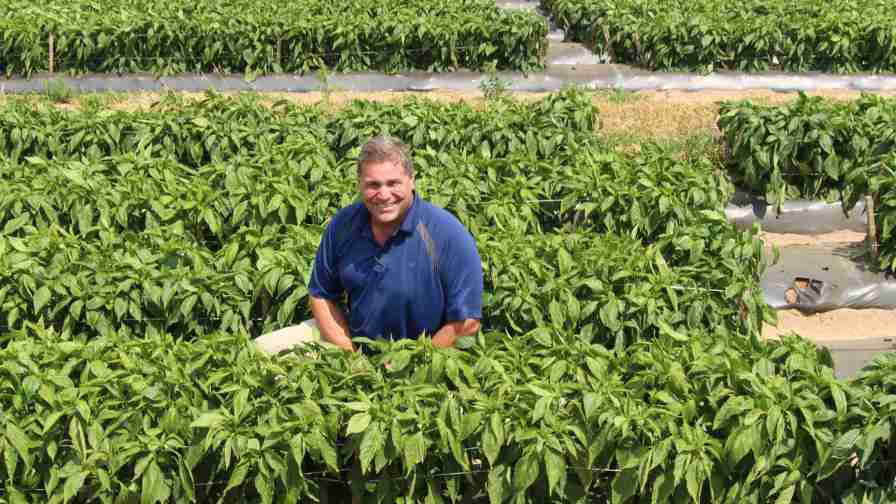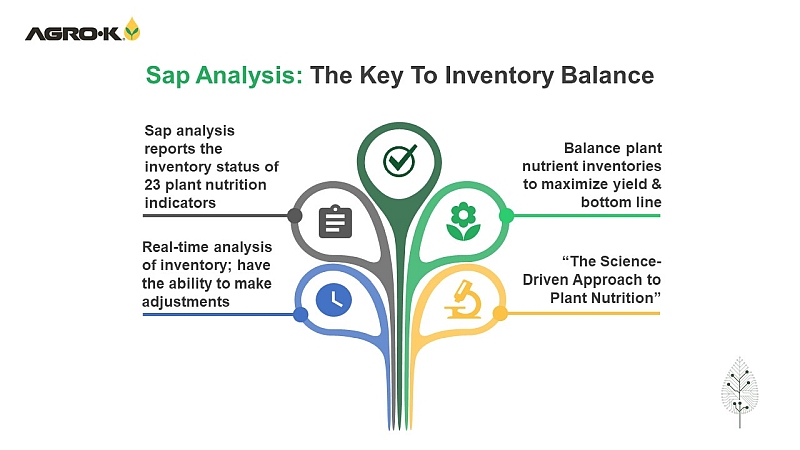A Laser Focus On Peppers

Jason Kuehnle of Michigan-based Golden Plain Farms found his niche growing peppers.
Photo credit: Christina Herrick
Jason Kuehnle is hard-working and determined. As a young man, he left his father’s diverse fruit and vegetable operation to pursue his own farming dreams. In the last 20 years, he has grown his own business from 50 acres to the 450 acres it is today, becoming one of the top pepper producers in Southwest Michigan.
His operation, Golden Plain Farms, is situated about 15 miles from Lake Michigan. According to Kuehnle, the lake is a great moderator for fruit and vegetable crops, protecting them from frost in the spring and keeping temperatures warm into the fall.
The bell pepper farm is spread out over 20 miles, which provides further insurance against pests, diseases, and weather events, Kuehnle says.
Dedication To One Crop
Why focus on just one crop? It didn’t start out that way, Kuehnle says. When he began his own farm, he was producing peppers as well as different types of squash and cucumbers. It was bell peppers, however, that seemed to do very well in his area of Michigan, and there was a demand for the crop.
When Kuehnle realized that peppers were his main bread and butter, he opted to discontinue producing other crops. He says he was being diverse for the sake of being diverse and, for him, it wasn’t a good reason.
“In college classes and when you talk to other growers, you get hammered over the head about being diverse. For me, it was the opposite,” he says. “When I was producing several crops, I was compromising on what to do with labor, land, capital, and other equipment, like sprayers. So in my case, specializing in peppers has been beneficial.
“That doesn’t mean that everything is perfect,” he continues. “But that laser focus helps us get through weather and diseases a lot better than it did when we had more than one crop.”
Find Your Niche
Should other growers opt to go the monocrop route? Kuehnle says every operation is unique. For his farm, he says by growing one crop and doing an exceptional job, it has proved to be better than producing several crops and doing an average job.
In addition to finding his niche producing peppers, Kuehnle says one of his secrets to success has been finding good people to work with.
“I’ve been blessed to work with good employees, vendors, and have good representation in the market. It is important to have as many good people as you can around you because you can’t do this by yourself. You need help, or at least I did.”
In terms of representation in the markets, Kuehnle says having solid relationships with two Florida-based distributors, Pero Family Farms and Lombardi Produce, has allowed Golden Plain Farms to achieve economic stability when markets are low.
“Being aligned with companies that are really good at what they do and are in the marketplace 365 days of the year has enabled us to capture contracts that we couldn’t have otherwise, because our season is so short and we only offer one crop,” Kuehnle says.
Variety Trial And Error
Variety choice also is critical when you produce just one crop. Kuehnle grows a mixture of eight different pepper varieties, several of which are resistant to 10 races of bacterial spot, the farm’s most troublesome disease. These resistant varieties include ‘9325’ and ‘Aristotle’ (Seminis).
“During the early season, we go with ‘Aristotle’ because it’s earlier and it yields heavily earlier. For mid-season, we use ‘Currier’ and ‘Karisma’ (Harris Moran), and for the later season, we use ‘9325,’” he explains.
Variety performance is largely dependent on timing, according to Kuehnle.
“We noticed that if we planted some of the 10-race-resistant varieties early, they didn’t get bacterial spot, but the crop wasn’t very marketable. Then we would plant them late, and they were beautiful.”
Market demand for “perfect” peppers is strong, Kuehnle says, and peppers are required to be a good size, have blocky uniformity, and be darker in color.
“I start planting in the middle of May, and we have plantings until after the Fourth of July. We plant for a long time to ensure we always have first pick crown pepper all the way through the season for our contracts. We harvest four or five times, and the first two harvests are generally the highest quality and the largest size,” he says.
Maintaining A Stable Workforce
While Golden Plain Farms has been lucky to have a stable workforce through the changing labor landscape, Kuehnle is not without his concerns.
“Labor is probably our biggest challenge. We have been able to get our crops harvested, but each year it’s been nail biting. [The workers] come later and later, and labor is not as plentiful as it used to be,” he laments.
The operation relies completely on foreign labor, and for the first time ever, Kuehnle is considering using the H-2A program to ensure that there are enough workers for the next season.
“If you can’t pick it, what’s the point in trying to grow it?” he asks.
Despite the uncertainty, Kuehnle does have a strategy when it comes to retaining his workers. It’s a simple, but effective strategy: Treat workers with respect and as equals.
“We’ve had some employees that have been with us for 20 years. We do our best to try to retain our employees, and we make sure to let them know how valued they are. Friday afternoon, when I hand out paychecks, I take the time to go to each and every one of them and thank them for the work that they’ve done,” he explains.
Expansion Plans
While the operation does intend to expand, Kuehnle says that expansion will happen only as the market allows.
“Over the last four to five years, we have grown incrementally, but we haven’t had large growth primarily because of the uncertainty of labor,” he says.
By looking at H-2A and other ways to improve the current labor situation, Kuehnle is sure that growth will occur steadily and over time.
Postharvest Management And Food Safety
Golden Plain Farms in Hartford, MI, has its own packinghouse on site, which processes more than 500,000 packages a year to keep up with demand.
“My packingline is quite large. We have to have enough space with enough people to do the packs our customers are asking for. We have some areas where we used to pack extra-large and jumbo peppers where there may have been six people [on the line] in the past, and now there are 30,” says Jason Kuehnle, the farm’s owner.
The operation is looking at different technologies in the packinghouse that may help reduce labor, including computer sizers and graders. While they have used them in the past, the technology was not ideal for bell peppers because of their unique shape.
“Even a perfectly shaped bell pepper may have valleys that create shadows and make it harder to get that 360° view the way a person can,” he explains. “But with the technology available now, we can go toward that in the very near future.”
Food safety is another major area of focus for Golden Plain Farms, and as Kuehnle explains, it’s something that needs to be taken into account with every decision.
“We’re replacing older equipment with stainless-steel equipment and other materials that are easier to clean and prepared for food safety audits,” he says.
Instead of food safety being a pressure point, Kuehnle believes that he can turn one of his greatest struggles into one of his greatest strengths.
“We have to think about it differently, he explains. “We can say that by doing this we are differentiating ourselves from our competitors and ensuring in the future we will not be subject to a recall.”
Sustainable Water Use
Water is one of the most important resources for Golden Plain Farms to protect. For this reason, the bell pepper grower located in Southwestern Michigan has taken measures to monitor irrigation practices to make sure they are not overwatering.
“In Michigan, we are fortunate water is plentiful, but that doesn’t mean we can take it for granted,” says Jason Kuehnle, the farm’s owner.
Within the last few years, the farm moved from a system where it watered fewer times at longer durations to a system where irrigation takes place at more frequent intervals, but for less time overall.
“Everything we grow is on raised beds with plastic and is drip irrigated. We also use irrigation tubes spread throughout the field that monitor moisture at three different depths,” Kuehnle explains. “We want to keep the water and the nutrients where the roots are so they can utilize it. By doing that, we end up using less water.”









